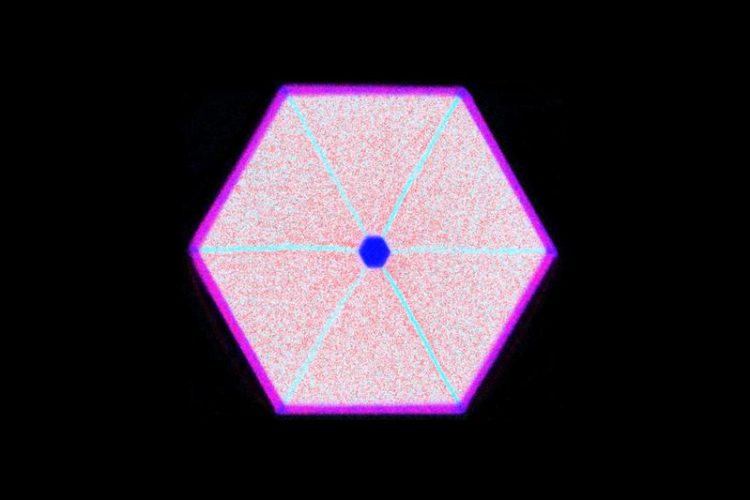Shell increases versatility of nanowires

Cross-section of a nanowire featuring a gallium arsenide core, an indium aluminum arsenide shell, and an indium gallium arsenide capping layer (via energy-dispersive X-ray spectroscopy). HZDR / René Hübner
Nanowires are extremely versatile. The tiny elements can be used for miniaturized photonic and electronic components in nanotechnology. Applications include optical circuits on chips, novel sensors, LEDs, solar cells and innovative quantum technologies.
It is the free-standing nanowires that ensure the compatibility of more recent semiconductor technologies with conventional silicon-based technologies. Since contact to the silicon substrate is tiny, they surmount typical difficulties in combining different materials.
For their study, which lasted several years, the Dresden researchers first set about growing nanowires from the semiconductor material gallium arsenide on silicon substrates. The next step involved enclosing the wafer-thin wires in another layer of material to which they added indium as an additional element.
Their goal: the mismatched crystal structure of the materials was intended to induce a mechanical strain in the wire core, which changes the electronic properties of gallium arsenide. For instance, the semiconductor bandgap becomes smaller and the electrons become more mobile. To magnify this effect, the scientists kept adding more indium to the shell, or increased the shell’s thickness. The result went way beyond expectations.
Taking a known effect to extremes
“What we did was take a known effect to extremes,” explained Emmanouil Dimakis, leader of the study that involved researchers from HZDR, TU Dresden and DESY in Hamburg. “The seven percent of strain achieved was tremendous.”
At this level of strain, Dimakis had expected to see disorders occurring in the semiconductors: in their experience, the wire core bends or defects arise. The researchers believe that the special experimental conditions were the reason for the absence of such disorders: First, they grew extremely thin gallium arsenide wires – around five thousand times finer than a human hair.
Second, the team managed to produce the wire shell at unusually low temperatures. Surface diffusion of atoms is then more or less frozen, forcing the shell to grow evenly around the core. The team of researchers reinforced their discovery by conducting several independent series of measurements at facilities in Dresden, as well as at the high-brilliance X-ray light sources PETRA III in Hamburg and Diamond in England.
The extraordinary results led the researchers to undertake further investigations: “We shifted our focus to the question of what triggers the extremely high strain in the nanowire core, and how this can be used for certain applications,” Dimakis recollected. “Scientists have been aware of gallium arsenide as a material for years, but nanowires are special. A material may exhibit completely new properties at the nanoscale.”
Potential applications for fiber-optic networks
The researchers realized that the high strain let them shift the bandgap of the gallium arsenide semiconductor to very low energies, making it compatible even for wavelengths of fiber-optic networks. A technological milestone. After all, this spectral range could previously only be achieved via special alloys containing indium, which caused a number of technological problems due to the material mix.
High-precision methods are required to produce nanowires. Four years ago, a special system was installed at HZDR for this purpose: the molecular beam epitaxy laboratory. The self-catalyzed growth of nanowires from beams of atoms or molecules is achieved in the lab; the beams are directed onto silicon substrates in ultra-high-vacuum. Emmanouil Dimakis played a major part in setting up the lab. Most of the studies reported in the current publication were carried out by Leila Balaghi as part of her doctorate.
Dr. Emmanouil Dimakis
Institute of Ion Beam Physics and Materials Research at HZDR
Phone +49 351 260 2765 | email: e.dimakis@hzdr.de
L. Balaghi, G. Bussone, R. Grifone, R. Hübner, J. Grenzer, M. Ghorbani-Asl, A.V. Krasheninnikov, H. Schneider, M. Helm, and E. Dimakis: Widely tunable GaAs bandgap via strain engineering in core/shell nanowires with large lattice mismatch, in Nature Communications (doi: 10.1038/s41467-019-10654-7)
Media Contact
All latest news from the category: Materials Sciences
Materials management deals with the research, development, manufacturing and processing of raw and industrial materials. Key aspects here are biological and medical issues, which play an increasingly important role in this field.
innovations-report offers in-depth articles related to the development and application of materials and the structure and properties of new materials.
Newest articles

A ‘language’ for ML models to predict nanopore properties
A large number of 2D materials like graphene can have nanopores – small holes formed by missing atoms through which foreign substances can pass. The properties of these nanopores dictate many…

Clinically validated, wearable ultrasound patch
… for continuous blood pressure monitoring. A team of researchers at the University of California San Diego has developed a new and improved wearable ultrasound patch for continuous and noninvasive…

A new puzzle piece for string theory research
Dr. Ksenia Fedosova from the Cluster of Excellence Mathematics Münster, along with an international research team, has proven a conjecture in string theory that physicists had proposed regarding certain equations….



